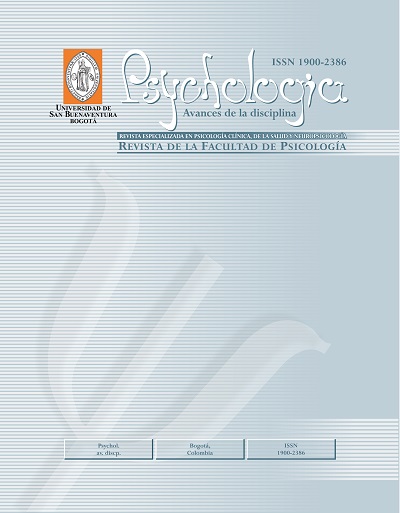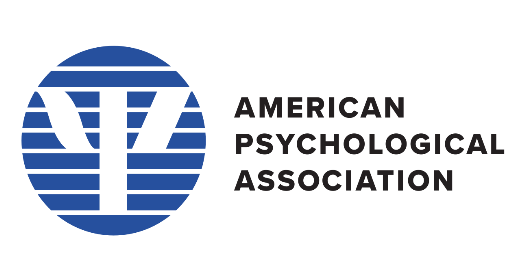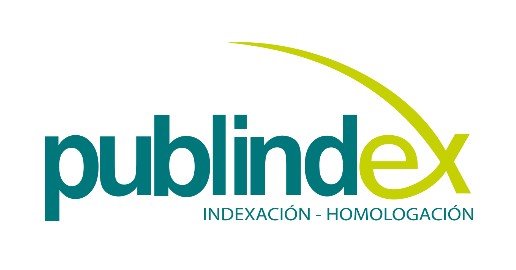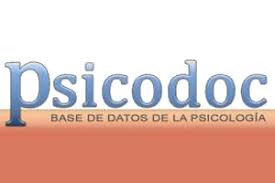View/Download
How to Cite
Dominguez-Lara, S. A., & Sánchez-Carreño, K. L. (2017). Using cognitive emotion regulation when disapprove a test: the role of academic self-efficacy in college students. Psychologia, 11(2), 99–112. https://doi.org/10.21500/19002386.2716
More Citation Formats
License terms
▼
This journal provides open, immediate access to its contents, based on the principle that offering the public free access to research helps to promote a higher global exchange of knowledge.
As such, all journal articles are published under a Creative Commons Attribution-NonCommercial-ShareAlike 4.0 International License (CC BY-NC-SA), by which commercial use of the original work or its possible derived works is not allowed, and the distribution thereof must be done with the same license elements regulating the original work.
http://creativecommons.org/licenses/by-nc-sa/4.0/
Abstract
The research about cognitive emotional regulation (cognitive coping) is of big importance in the academic context, where several stressful events are present, and it is necessary to implement strategies to minimize their emotional impact. In this sense, the academic self-efficacy (ASE) would be related to the use of some strategies, which could lead the student to a more adaptive performance throughout the period of studies, especially when he disapproves of an test. Therefore, the aim of the present study was to evaluate the association between ASE and cognitive coping strategies in front of the situation of disapproving a test in a sample of 150 psychology students (74% women, Mage = 22.38). Was used the Cognitive Emotional Regulation Questionarie - 18, whose instructions focused on the exam disapproval situation, and the Single Item Academic Self-Efficacy, which would represent the perceived ASE grades. The results indicate that when more ASE, the more frequent the use of strategies such as Acceptance and Refocus on planing; and a low AA is related with Rumination and Catastrophizing. The theoretical and practical implications of the findings are discussed.
References
Aldao, A., Nolen-Hoeksema, S., & Schweizer, S. (2010). Emotion-regulation strategies across psychopathology: A meta-analytic review. Clinical Psychology Review, 30(2), 217–237. doi: 10.1016/j.cpr.2009.11.004
Álvarez, O. (2010). Procrastinación general y académica en una muestra estudiantes de secundaria de Lima. Persona, 13, 159-177.
Anderson, J.C., & Gerbing D.W. (1988): Structural Equation Modeling in Practice: A Review and Recommended Two - Step Approach. Psychological Bulletin, 103, 411-423. doi: 10.1037/0033-2909.103.3.411
Ato, M., López, J., & Benavente, A. (2013). Un sistema de clasificación de los diseños de investigación en psicología. Anales de Psicología, 29(3), 1038-1059. doi: 10.6018/analesps.29.3.178511
Bandura, A. (1997) Self – Efficacy. The Exercice of Control. New York: W. H. Freeman and Company.
Bandura, A. (2001a). Social cognitive theory: An agentive perspective. Annual Review of Psychology, 52(1), 1–26. doi: 10.1146/annurev.psych.52.1.1
Bandura, A. (2001b). Guía para la Construcción de Escalas de Autoeficacia. Recuperado de: https://www.uky.edu/~eushe2/Pajares/effguideSpanish.html
Blanco, A. (2010). Creencias de autoeficacia de estudiantes universitarios: un estudio empírico sobre la especificidad del constructo. Revista Electrónica de Investigación y Evaluación Educativa, 16(1), 1-28.
Carver, C., & Scheier, M. (1994). Situational coping and coping dispositions in a stressful encounter. Journal of Personality and Social Psychology, 66(1), 184-195. doi: 10.1037/0022-3514.66.1.184
Cronbach L.J. (1951). Coefficient alpha and the internal structure of tests. Psychometrika, 16(3), 297-334. doi: 10.1007/BF02310555
De Winter, J.C.F., Gosling, S.D., & Potter, J. (2016). Comparing the Pearson and Spearm correlation coefficients across distributions and simple size: a tutorial using simulations and empirical data. Psychological Methods. doi: 10.1037/met0000079
Dominguez-Lara, S. (en revisión). Influencia de las estrategias cognitivas de regulación emocional sobre la ansiedad y depresión en universitarios: análisis preliminar.
Dominguez-Lara, S. (en prensa a). Afrontamiento ante la ansiedad pre-examen y autoeficacia académica en estudiantes de ciencias de la salud. Educación Médica. doi: 10.1016/j.edumed.2016.07.007
Dominguez-Lara, S. (en prensa b). Evaluación de la confiabilidad del constructo mediante el Coeficiente H: breve revisión conceptual y aplicaciones. Psychologia: Avances en la disciplina.
Dominguez-Lara, S. (en prensa c). Magnitud del efecto en comparaciones entre 2 o más grupos. Revista de Calidad Asistencial. doi: 10.1016/j.cali.2016.04.002
Dominguez, S. (2014). Autoeficacia para situaciones académicas en estudiantes universitarios peruanos: un enfoque de ecuaciones estructurales. Revista de Psicología – UCSP, 4, 45-53.
Dominguez-Lara, S., & Medrano, L. (2016). Propiedades psicométricas del Cognitive Emotional Regulation Questionnarie (CERQ) en estudiantes universitarios de Lima. Psychologia: Avances de la Disciplina, 10(1), 53 - 67. doi: 10.21500/19002386.2466
Dominguez-Lara, S, & Merino-Soto, C. (En prensa). Fiabilidad por consistencia interna de medidas de un solo ítem. Actas Urológicas Españolas. doi; 10.1016/j.acuro.2016.04.003
Dominguez, S., & Merino, C. (2015a). Una versión breve del Cognitive Emotional Regulation Questionnarie: Análisis estructural del CERQ-18 en estudiantes universitarios limeños. Revista Peruana de Psicología y Trabajo Social, 4(1), 25-36.
Dominguez, S. & Merino C. (2015b). ¿Por qué es importante reportar los intervalos de confianza del coeficiente alfa de Cronbach? Revista Latinoamericana de Ciencias Sociales, Niñez y Juventud, 13(2), 1326-1328.
Dominguez, S., Villegas, G., Cabezas, M., Aravena, S., & De la Cruz, M. (2013). Autoeficacia académica y ansiedad ante los exámenes en estudiantes de psicología de una universidad privada. Revista de Psicología – UCSP, 3, 13-23.
Feldt, L. S. & Kim, S. (2006). Testing the difference between two alpha coefficients with small samples of subjects and raters. Educational and Psychological Measurement, 66(4), 589-600. doi: 10.1177/0013164405282488
Fritz, C.O., Morris, P.E., & Richler, J.J. (2012). Effect size estimates: current use, calculations, and interpretation. Journal of Experimental Psychology: General, 141, 2-18. doi: 10.1037/a0024338
Garnefsky, N., & Kraaij, V. (2007). The Cognitive Emotion Regulation Questionarie: Psychometric features and prospective relationships with depression and anxiety in adults. European Journal of Psychological Assessment, 23(3), 141-149. doi: 10.1027/1015-5759.23.3.141
Garnefski, N., Baan, N., & Kraaij, V. (2005). Psychological distress and cognitive emotion regulation strategies among farmers who fell victim to the foot-and-mouth crisis. Personality and Individual Differences, 38, 1317-27. doi: 10.1016/j.paid.2004.08.014
Garnefsky, N., Kraaij, V., & Spinhoven, P. (2002). Manual for the use of Cognitive Emotion Regulation Questionarie. Leiderdorp, the Netherlands: DATEC.
Grissom, R.J., & Kim, J.J. (2005). Effec size for research. A broad practical approach. New Jersey: Lawrence Erlbaum Associates.
Hancock, G. R., & Mueller, R. O. (2001). Rethinking construct reliability within latent variable systems. In R. Cudeck, S. H. C. du Toit, & D. Sörbom (Eds.), Structural equation modeling: Past and present. A Festschrift in honor of Karl G. Jöreskog (pp. 195–261). Chicago: Scientific Software International.
Hanley, A.W., Palejwala, M.H., Hanley, R.T., Canto, A.I., & Garland, E.L. (2015). A failure of mind: Dispositional mindfulness and positive reappraisal as predictors of academic self-efficacy following failure. Personality and Individual Differences, 86, 332 – 337. doi: 10.1016/j.paid.2015.06.033
Jamieson, J. P., Nock, M. K., & Mendes, W. B. (2012). Mind over matter: Reappraising arousal improves cardiovascular and cognitive responses to stress. Journal of Experimental Psychology: General, 141(3), 417–22. doi: 10.1037/a0025719
Joormann, J., & D’Avanzato, C. (2010). Emotion regulation in depression: Examining the role of cognitive processes. Cognition & Emotion, 24(6), 913–939. doi: 10.1080/02699931003784939
Kraaij, V., Garnefski, N., & Schroevers, M.J. (2009). Coping, goal adjustment, and positive and negative affect in definitive infertility. Journal of Health Psychology, 14(1), 18 – 26. doi: 10.1177/1359105308097939
Kraaij, V., Garnefski, N., & van Gerwen, L. (2003). Cognitive coping and anxiety among people with fear of flying. En R. Bor & L. van Gerwen (Eds.), Psychological Perspectives on Fear of Flying (pp. 89-99). Hampshire: Ashgate.
Malgady, R. (2007). How skew are psychological data? A standardized index of effect size. The Journal of General Psychology, 134(3), 355-359. doi: 10.3200/GENP.134.3.355-360
McDonald R. P. (1999). Test theory: A unified treatment. Mahwah, N.J.: L. Erlbaum Associates.
Merino-Soto, C. (2016). Diferencias entre coeficientes alfa de Cronbach, con muestras y partes pequeñas: Un programa VB. Anales de Psicología, 32(2), 587 – 588. doi: 10.6018/analesps.32.2.203841
Merino, C., & Lautenschlager, G. (2003). Comparación estadística de la confiabilidad alfa de Cronbach: Aplicaciones en la medición educacional. Revista de Psicología – Universidad de Chile, 12, 129–139.
Micceri, T. (1989). The unicorn, the normal curve and other improbable creatures. Psychological Bulletin, 105(1), 156-166. doi: 10.1037/0033-2909.105.1.156
Ortiz, A. (2015). Neuroeducación ¿Cómo aprende el cerebro humano y cómo deberían enseñar los docentes? Bogotá: Ediciones de la U.
Ponterotto, J.G., & Charter, R.A. (2009). Statistical extensions of Ponterotto and Ruckdeschel´s (2007) reliability matriz for estimating the adecuacy of internal consistency coefficients. Perceptual and Motor Skills,108, 878 – 886. doi: 10.2466/PMS.108.3.878-886
Shapiro, S.S., & Wilk, M.B. (1965). An Analysis of Variance Test for Normality (complete Samples). Biometrika, 52(3/4), 591-611. doi : 10.1093/biomet/52.3-4.591
Sorbom, D., & Joreskog, K. G. (1982). The use of structural equation models in evaluation research. In C. Fornell (Ed.), A second generation of multivariate analysis (Vol. 2, pp. 381 -418). New York: Praeger.
Tuna, E., & Bozo, O. (2012). The Cognitive Emotion Regulation Questionnarie: Factor structure and psychometric properties of the Turkish version. Journal of Psychopathology and Behavioral Assessment, 34(4), 564-570. doi: 10.1007/s10862-012-9303-8
Álvarez, O. (2010). Procrastinación general y académica en una muestra estudiantes de secundaria de Lima. Persona, 13, 159-177.
Anderson, J.C., & Gerbing D.W. (1988): Structural Equation Modeling in Practice: A Review and Recommended Two - Step Approach. Psychological Bulletin, 103, 411-423. doi: 10.1037/0033-2909.103.3.411
Ato, M., López, J., & Benavente, A. (2013). Un sistema de clasificación de los diseños de investigación en psicología. Anales de Psicología, 29(3), 1038-1059. doi: 10.6018/analesps.29.3.178511
Bandura, A. (1997) Self – Efficacy. The Exercice of Control. New York: W. H. Freeman and Company.
Bandura, A. (2001a). Social cognitive theory: An agentive perspective. Annual Review of Psychology, 52(1), 1–26. doi: 10.1146/annurev.psych.52.1.1
Bandura, A. (2001b). Guía para la Construcción de Escalas de Autoeficacia. Recuperado de: https://www.uky.edu/~eushe2/Pajares/effguideSpanish.html
Blanco, A. (2010). Creencias de autoeficacia de estudiantes universitarios: un estudio empírico sobre la especificidad del constructo. Revista Electrónica de Investigación y Evaluación Educativa, 16(1), 1-28.
Carver, C., & Scheier, M. (1994). Situational coping and coping dispositions in a stressful encounter. Journal of Personality and Social Psychology, 66(1), 184-195. doi: 10.1037/0022-3514.66.1.184
Cronbach L.J. (1951). Coefficient alpha and the internal structure of tests. Psychometrika, 16(3), 297-334. doi: 10.1007/BF02310555
De Winter, J.C.F., Gosling, S.D., & Potter, J. (2016). Comparing the Pearson and Spearm correlation coefficients across distributions and simple size: a tutorial using simulations and empirical data. Psychological Methods. doi: 10.1037/met0000079
Dominguez-Lara, S. (en revisión). Influencia de las estrategias cognitivas de regulación emocional sobre la ansiedad y depresión en universitarios: análisis preliminar.
Dominguez-Lara, S. (en prensa a). Afrontamiento ante la ansiedad pre-examen y autoeficacia académica en estudiantes de ciencias de la salud. Educación Médica. doi: 10.1016/j.edumed.2016.07.007
Dominguez-Lara, S. (en prensa b). Evaluación de la confiabilidad del constructo mediante el Coeficiente H: breve revisión conceptual y aplicaciones. Psychologia: Avances en la disciplina.
Dominguez-Lara, S. (en prensa c). Magnitud del efecto en comparaciones entre 2 o más grupos. Revista de Calidad Asistencial. doi: 10.1016/j.cali.2016.04.002
Dominguez, S. (2014). Autoeficacia para situaciones académicas en estudiantes universitarios peruanos: un enfoque de ecuaciones estructurales. Revista de Psicología – UCSP, 4, 45-53.
Dominguez-Lara, S., & Medrano, L. (2016). Propiedades psicométricas del Cognitive Emotional Regulation Questionnarie (CERQ) en estudiantes universitarios de Lima. Psychologia: Avances de la Disciplina, 10(1), 53 - 67. doi: 10.21500/19002386.2466
Dominguez-Lara, S, & Merino-Soto, C. (En prensa). Fiabilidad por consistencia interna de medidas de un solo ítem. Actas Urológicas Españolas. doi; 10.1016/j.acuro.2016.04.003
Dominguez, S., & Merino, C. (2015a). Una versión breve del Cognitive Emotional Regulation Questionnarie: Análisis estructural del CERQ-18 en estudiantes universitarios limeños. Revista Peruana de Psicología y Trabajo Social, 4(1), 25-36.
Dominguez, S. & Merino C. (2015b). ¿Por qué es importante reportar los intervalos de confianza del coeficiente alfa de Cronbach? Revista Latinoamericana de Ciencias Sociales, Niñez y Juventud, 13(2), 1326-1328.
Dominguez, S., Villegas, G., Cabezas, M., Aravena, S., & De la Cruz, M. (2013). Autoeficacia académica y ansiedad ante los exámenes en estudiantes de psicología de una universidad privada. Revista de Psicología – UCSP, 3, 13-23.
Feldt, L. S. & Kim, S. (2006). Testing the difference between two alpha coefficients with small samples of subjects and raters. Educational and Psychological Measurement, 66(4), 589-600. doi: 10.1177/0013164405282488
Fritz, C.O., Morris, P.E., & Richler, J.J. (2012). Effect size estimates: current use, calculations, and interpretation. Journal of Experimental Psychology: General, 141, 2-18. doi: 10.1037/a0024338
Garnefsky, N., & Kraaij, V. (2007). The Cognitive Emotion Regulation Questionarie: Psychometric features and prospective relationships with depression and anxiety in adults. European Journal of Psychological Assessment, 23(3), 141-149. doi: 10.1027/1015-5759.23.3.141
Garnefski, N., Baan, N., & Kraaij, V. (2005). Psychological distress and cognitive emotion regulation strategies among farmers who fell victim to the foot-and-mouth crisis. Personality and Individual Differences, 38, 1317-27. doi: 10.1016/j.paid.2004.08.014
Garnefsky, N., Kraaij, V., & Spinhoven, P. (2002). Manual for the use of Cognitive Emotion Regulation Questionarie. Leiderdorp, the Netherlands: DATEC.
Grissom, R.J., & Kim, J.J. (2005). Effec size for research. A broad practical approach. New Jersey: Lawrence Erlbaum Associates.
Hancock, G. R., & Mueller, R. O. (2001). Rethinking construct reliability within latent variable systems. In R. Cudeck, S. H. C. du Toit, & D. Sörbom (Eds.), Structural equation modeling: Past and present. A Festschrift in honor of Karl G. Jöreskog (pp. 195–261). Chicago: Scientific Software International.
Hanley, A.W., Palejwala, M.H., Hanley, R.T., Canto, A.I., & Garland, E.L. (2015). A failure of mind: Dispositional mindfulness and positive reappraisal as predictors of academic self-efficacy following failure. Personality and Individual Differences, 86, 332 – 337. doi: 10.1016/j.paid.2015.06.033
Jamieson, J. P., Nock, M. K., & Mendes, W. B. (2012). Mind over matter: Reappraising arousal improves cardiovascular and cognitive responses to stress. Journal of Experimental Psychology: General, 141(3), 417–22. doi: 10.1037/a0025719
Joormann, J., & D’Avanzato, C. (2010). Emotion regulation in depression: Examining the role of cognitive processes. Cognition & Emotion, 24(6), 913–939. doi: 10.1080/02699931003784939
Kraaij, V., Garnefski, N., & Schroevers, M.J. (2009). Coping, goal adjustment, and positive and negative affect in definitive infertility. Journal of Health Psychology, 14(1), 18 – 26. doi: 10.1177/1359105308097939
Kraaij, V., Garnefski, N., & van Gerwen, L. (2003). Cognitive coping and anxiety among people with fear of flying. En R. Bor & L. van Gerwen (Eds.), Psychological Perspectives on Fear of Flying (pp. 89-99). Hampshire: Ashgate.
Malgady, R. (2007). How skew are psychological data? A standardized index of effect size. The Journal of General Psychology, 134(3), 355-359. doi: 10.3200/GENP.134.3.355-360
McDonald R. P. (1999). Test theory: A unified treatment. Mahwah, N.J.: L. Erlbaum Associates.
Merino-Soto, C. (2016). Diferencias entre coeficientes alfa de Cronbach, con muestras y partes pequeñas: Un programa VB. Anales de Psicología, 32(2), 587 – 588. doi: 10.6018/analesps.32.2.203841
Merino, C., & Lautenschlager, G. (2003). Comparación estadística de la confiabilidad alfa de Cronbach: Aplicaciones en la medición educacional. Revista de Psicología – Universidad de Chile, 12, 129–139.
Micceri, T. (1989). The unicorn, the normal curve and other improbable creatures. Psychological Bulletin, 105(1), 156-166. doi: 10.1037/0033-2909.105.1.156
Ortiz, A. (2015). Neuroeducación ¿Cómo aprende el cerebro humano y cómo deberían enseñar los docentes? Bogotá: Ediciones de la U.
Ponterotto, J.G., & Charter, R.A. (2009). Statistical extensions of Ponterotto and Ruckdeschel´s (2007) reliability matriz for estimating the adecuacy of internal consistency coefficients. Perceptual and Motor Skills,108, 878 – 886. doi: 10.2466/PMS.108.3.878-886
Shapiro, S.S., & Wilk, M.B. (1965). An Analysis of Variance Test for Normality (complete Samples). Biometrika, 52(3/4), 591-611. doi : 10.1093/biomet/52.3-4.591
Sorbom, D., & Joreskog, K. G. (1982). The use of structural equation models in evaluation research. In C. Fornell (Ed.), A second generation of multivariate analysis (Vol. 2, pp. 381 -418). New York: Praeger.
Tuna, E., & Bozo, O. (2012). The Cognitive Emotion Regulation Questionnarie: Factor structure and psychometric properties of the Turkish version. Journal of Psychopathology and Behavioral Assessment, 34(4), 564-570. doi: 10.1007/s10862-012-9303-8
Downloads
Download data is not yet available.





















